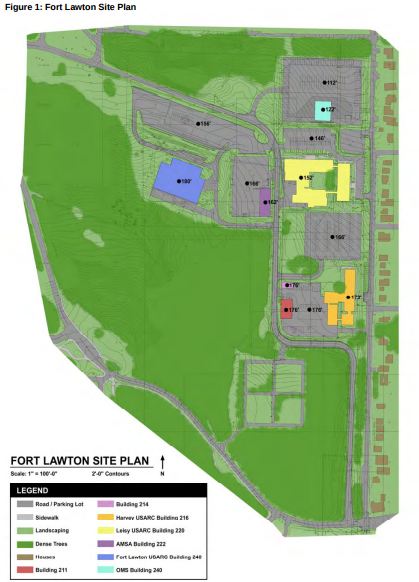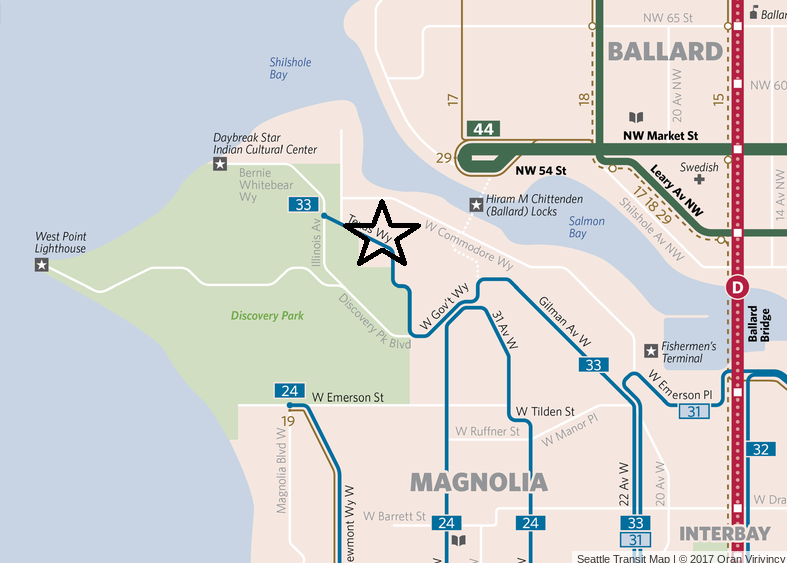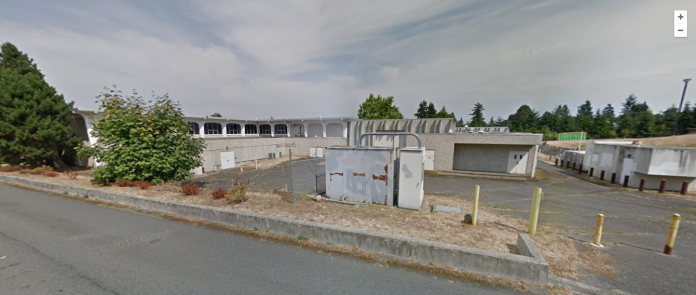After more than a decade of delays, a plan to build more than 200 affordable housing units on a 28-acre site at Fort Lawton Army Reserve Center in Magnolia may finally be picking up momentum. The Seattle Office of Housing hosted a meeting Monday to gather input, and there’s another one at 6.30pm this evening at the Magnolia Community Center.
Some neighbors opposed the plan, favoring additional park space or a school instead. Others recognized the urgency of producing affordable housing, particularly on land the City has access to for free under a federal program that seeks to put surplus land to good use. In fact, the urgency results not just from the crisis in housing affordability, but also because the City threatens to lose control of the site if it doesn’t act soon.
History of Re-purposing Fort Lawton
Set up as an army installation in the 1890s, Fort Lawton also had the purpose of protecting against the internal threat the government believed the Northwest’s labor movement posed, according to author Jack Hamann. In 1964, 85% of Fort Lawton was declared surplus and sold to the City at half market value to create Discovery Park. In 1970, after the United Indians of All Tribes (UIAT) presented a claim to all lands that might be declared surplus, the City negotiated an agreement to lease 17 acres to UIAT for what would become Daybreak Star Cultural Center.

In 2005, the federal government deactivated the last remnants of Fort Lawton, which was serving as a regional Army Reserve command center. “The Army named the City of Seattle the Local Redevelopment Authority (LRA), responsible for preparing and implementing a redevelopment plan,” the City website states. We’re still waiting on the plan 12 years later, and our inaction could cost us: if the City’s doesn’t act before its recently signed five year lease is up, the federal government can sell the property to a for-profit development. Writing in The Seattle Times, Vernal Coleman explained the storied history of the affordable housing effort at the site:
The last attempt to redevelop the now empty Army Reserve Center property was scuttled in 2009 when the state Court of Appeals upheld a lower-court ruling that the city’s plan to build around 200 low-income rental and supportive housing units for the homeless would have to undergo a state environmental review.
But Elizabeth Campbell, the driver behind the Magnolia Neighborhood Planning Council lawsuit that stalled the previous redevelopment effort, says maintaining the property as a public park is the preferable option.

Diving Into EIS Process
Apparently needing to complete the lengthy process of state environmental review paired with the Great Recession stressing budgets led the City to basically give up on the project for a while. Now the City is steeling itself for environmental review. A scoping document indicated the lead agency (Seattle Office of Housing) has initially identified four alternatives to study via the Environmental Impact Statement (EIS) process, although it could potentially broaden the scope.
- Alternative 1: Mixed Income Affordable Housing and Public Park Uses – “Development of a mix of affordable housing onsite, including homeless and affordable rental and ownership housing, with a portion of the site likely rezoned to Lowrise residential zoning. Public park uses would also be created, including active park facilities, preserved existing natural areas and conversion of an existing structure to a park maintenance facility;”
- Alternative 2: Market Rate Housing Onsite & Affordable Housing Offsite – “Development of market rate single family housing under current zoning onsite, and construction of homeless and affordable housing at an off-site location;”
- Alternative 3: Public Park Onsite: Affordable Housing Offsite – “Development of the entire site as a public park, and construction of homeless and affordable housing at an off-site location; and”
- Alternative 4: No Action – “No redevelopment of the site; existing structures onsite would be maintained.”
Balancing Investments In New Park Land
Of course, the site being adjacent to 534-acre Discovery Park already has some of the best park access in the city. The neighborhood doesn’t have a shortage of park space, but it does have a shortage of affordable housing. We’d all love to have infinite park land ready-at-hand; nonetheless, the City must levy Parks Department resources equitably and it’s difficult to make an argument that Magnolia is a priority for these investments. In fact, one could argue Alternative 3 would divert investment from more open-space-deprived neighborhoods.
Alternative 1, on the other hand, would still add 15 acres to Discovery Park–allowing the Parks Department to utilize an existing building and preserving some forested areas–while also acknowledging the great need for affordable housing. The mix of housing being discussed is 75 to 100 units of permanent housing for the homeless, 85 rental units targeted at low-income seniors, and approximately 50 single-family homes targeted at moderate income folks, which potentially could be set up as a community land trust.
The Case For Affordable Housing In Fort Lawton
Seattle Office of Housing would be making a mistake to not develop housing on this large 28-acre lot that fell into its lap. Affordable housing providers face great difficulties acquiring land in Seattle’s supercharged market; to not put this site to its highest and best use would be a shame. If we were sizing the affordable housing to present need, rather than the need of a decade ago–when 200-some units was first proposed–then we’d be building even more affordable housing on the site, which has several qualities to commend it:
- Next to Seattle’s largest park;
- Near two highly rated public schools;
- Route 33 stops within the site;
- Ballard Locks provide walking access to Ballard (and Route 44).

Nonetheless, some neighbors oppose affordable housing on the site and our system tends to give them a megaphone as white wealthy landowners. Look no farther than King 5 coverage of the hearing on Monday which frames the project from the wealthy homeowner point-of-view that affordable housing jeopardizes their neighborhood. “Ask anyone who lives in Magnolia and they’ll tell you this place is something that must be protected,” the report begins. And the report continues right through Councilmember Sally Bagshaw reminding everyone this project would not touch the 532 acres of Discovery Park to end on the reporter concluding: “How can that be, neighbors asked, when the two are so intertwined; Change Fort Lawton and they feel you’ll be changing Discovery Park as well.”
The City must rank sheltering low-income people a higher priority than the desire of high-income Magnolia residents to not live in proximity to low-income folks. We must be ready to fight for our priorities. The Magnolia Neighborhood Planning Council filed the lawsuit that impeded the project the first time around, and it would not be surprising to see another attempt.
A second public meeting on the Fort Lawton redevelopment will take place tonight at 6.30pm at the Magnolia Community Center at 2550 34th Avenue W. Another way to comment is to email the Seattle Office of Housing at this address: OH_Comments@seattle.gov. Comments are due by 5pm on June 26th.
The City’s overview of the Fort Lawton process targets Fall 2017 for the Draft EIS, Winter 2018 for the Final EIS, and Spring/Summer 2018 for the proposed redevelopment plan to be delivered to Seattle City Council for yet more process.
I’ll leave you with the testimony of a supporter of the affordable housing plan, one Bob Kaminski, who attended the meeting on Monday and can give a sense of what the public meetings have been like thus far:
It was a packed room at Daybreak Star Indian Cultural Center. After the speakers from the city finished up, a number of people in the room loudly and angrily took the microphone to speak out against low-income housing in their neighborhoods. Much of it could also be qualified (in my view) as hate speech towards people experiencing homelessness, often totally off the topic of this proposed project. The Daybreak Star Center staff asked the crowd to respect their wishes to keep the mic off and direct comments towards the court reporter, but the rich white folks were not having any of it.
The first person to get on the mic (a self-described “low-income housing advocate”) made the traditional segregationist comment, “I fully support low-income housing, just not here in Magnolia”.
Second person (another self-described homeless and low-income housing advocate) took 8 minutes describing how he cares so much about transportation for the residents that the Housing office should scrap the proposal. The lack of transit access should keep low-income housing out of the area. He mentioned that he loves Magnolia because its effectively a quiet suburban enclave removed from the hustle-and-bustle of the city. (No mention of the fact that Magnolia was intentionally zoned and designed as a segregated community).
Third person gave a long spiel, totally unrelated to this proposal, effectively telling the crowd a single long anecdote about interacting with a homeless person near the Magnolia bridge, and saying that homeless people should be forcibly removed from Seattle. He mentioned he had interplay with Safe Seattle, an “anti-homelessness” group that advocates for encampment sweeps and harsh criminal penalties for drug use. This nice gentleman was very well-dressed, a local businessman by his own admission.
Fourth person was a member of United Indians of All Tribes, a Canadian First Nations member, and Daybreak Star staffer working on services for indigenous people experiencing houselessness. He gave an impassioned rundown of how homelessness destroys people and community, and what Daybreak Star is doing with their own folks about it. I didn’t write down his comments but there was a strong response from a subset of the crowd.
Fifth speaker was a pair of white women who were part of a group tabling at the doorway, asking the city to build a new school for the Magnolia youth on the site instead. Notably, it was an “either/or” statement, not a “both/and” one. Because the rich white homeowners are more important than housing people.
I spoke after them, opening by thanking UIAT (United Indians of All Tribes) and Daybreak Star for hosting in their building (which was created after an indigenous peoples’ occupation of Lawton in the 70s). Nobody–not the city officials or the speakers–had thanked them. Mentioned that US & Seattle are all built on land stolen from First Peoples by force of arms and violence. I opened by asking the room if anyone present had ever experienced homelessness. No hands raised. Asked if anyone in the room personally knew someone who had experienced homelessness, about 20-30 hands raised (out of ~70). Went on to say that these discussions were being held without input from the affected community. No houseless person’s voice was heard in that room…
By my estimation, though, about half of the people in the room were highly supportive of the Housing Office’s plans. Hopefully there will be some folks at the forum tomorrow night at Magnolia Community Center to support.
Doug Trumm is publisher of The Urbanist. An Urbanist writer since 2015, he dreams of pedestrian streets, bus lanes, and a mass-timber building spree to end our housing crisis. He graduated from the Evans School of Public Policy and Governance at the University of Washington in 2019. He lives in Seattle's Fremont neighborhood and loves to explore the city by foot and by bike.


